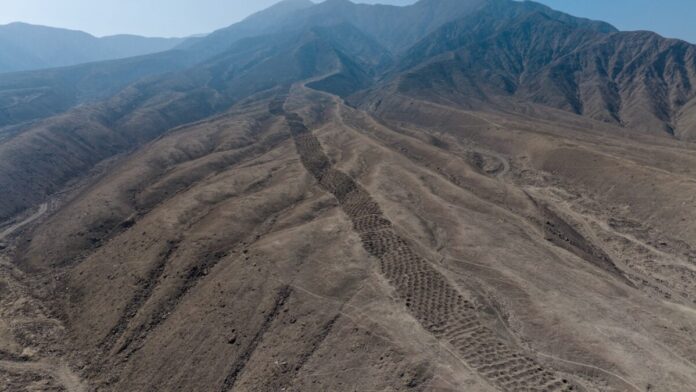In South America, a mysterious monument stretches almost a mile (1.5 kilometers) through the southern Peruvian Andes. Called Monte Sierpe, meaning serpent mountain, it consists of rows of around 5,200 aligned holes, and researchers have put forth a new theory for what they may have been.
In a study published today in the journal Antiquity, an international team of researchers conducted sediment analysis and took drone photography of Monte Sierpe. Their results suggest that the monument, also known as “Band of Holes,” was used by indigenous peoples in accounting and trade.
“Hypotheses regarding Monte Sierpe’s purpose range from defence, storage, and accounting to water collection, fog capture, and gardening,” Jacob Bongers, an archaeologist from the University of Sydney and lead author of the study, says in an Antiquity statement. “The function of the site remains unclear.”
Corn-filled holes
The holes are arranged into sections, and each hole is 3.3 to 6.6 feet (1 to 2 meters) wide and 1.6 to 3.3 feet (0.5 to 1 meters) deep. The team shed light on the perplexing monument on both the micro and macro levels, conducting microbotanical analysis of the holes’ sediments and capturing high-resolution aerial imagery. The microbotanical analysis revealed plant remains such as corn as well as wild plants traditionally used in basket making.
“These data support the hypothesis that during pre-Hispanic times, local groups periodically lined the holes with plant materials and deposited goods inside them, using woven baskets and/or bundles for transport,” Bongers explained.
What’s more, the aerial imagery suggests that the holes’ arrangement aligns with numerical patterns. The researchers argue that this, in addition to its segmented organization, makes Monte Sierpe like a giant khipu: a cord and knot documenting system used by Andean people. As such, Monte Sierpe may have been a giant accounting system that the Inca state utilized to collect tributes.
Bartering and accounting
The Inca were a pre-Columbian indigenous civilization best known for building Machu Picchu (recently also admired for this three-walled building), whose modern descendants are Andean Quechua-speaking people. Monte Sierpe would have been usefully located between two Inca administrative sites and in proximity to an intersection of pre-Hispanic roads. What’s more, it also sits between the highlands and lower coastal plain, an area where communities from both regions would have gathered for trade.
Altogether, the researchers propose that the pre-Inca Chincha Kingdom originally developed and used Monte Sierpe for controlled trade, which then turned into an Inca space for accounting.
“This study contributes an important Andean case study on how past communities modified past landscapes to bring people together and promote interaction,” Bongers concluded. “Our findings expand our understanding of barter marketplaces and the origins and diversity of Indigenous accounting practices within and beyond the ancient Andes.”

